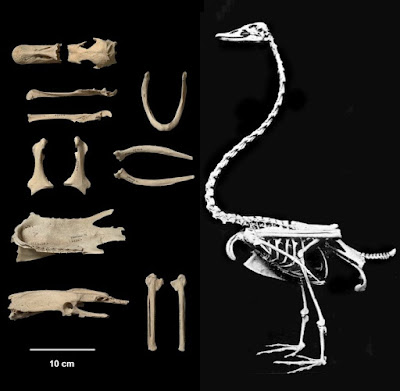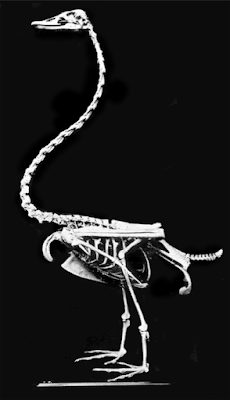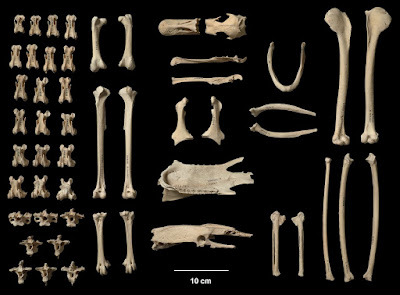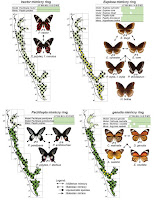 The skeleton of the poūwa, Cygnus sumnerensis (Forbes, 1890) |
Rawlence, Kardamaki, Easton, et al. 2017. Ancient DNA and Morphometric Analysis Reveal Extinction and Replacement of New Zealand's Unique Black Swans. Proceedings of the Royal Society B. DOI: 10.1098/rspb.2017.0876 |
Abstract
Prehistoric human impacts on megafaunal populations have dramatically reshaped ecosystems worldwide. However, the effects of human exploitation on smaller species, such as anatids (ducks, geese, and swans) are less clear. In this study we apply ancient DNA and osteological approaches to reassess the history of Australasia's iconic black swans (Cygnus atratus) including the palaeo-behaviour of prehistoric populations. Our study shows that at the time of human colonization, New Zealand housed a genetically, morphologically, and potentially ecologically distinct swan lineage (Cygnus sumnerensis, Poūwa), divergent from modern (Australian) C. atratus. Morphological analyses indicate C. sumnerensis exhibited classic signs of the ‘island rule’ effect, being larger, and likely flight-reduced compared to C. atratus. Our research reveals sudden extinction and replacement events within this anatid species complex, coinciding with recent human colonization of New Zealand. This research highlights the role of anthropogenic processes in rapidly reshaping island ecosystems and raises new questions for avian conservation, ecosystem re-wilding, and de-extinction.
KEYWORDS: ancient-DNA, Australia, black swan, Chatham Islands, Cygnus atratus, Cygnus sumnerensis, Q1 extinction, island rule, New Zealand, Poūwa, recolonization
 |
| The mounted bones of an extinct poūwa. Photo: Museum of New Zealand Te Papa Tongarewa |

Nicolas J. Rawlence, Afroditi Kardamaki, Luke J. Easton, Alan J. D. Tennyson, R. Paul Scofield and Jonathan M. Waters. 2017. Ancient DNA and Morphometric Analysis Reveal Extinction and Replacement of New Zealand's Unique Black Swans.
Proceedings of the Royal Society B. DOI: 10.1098/rspb.2017.0876
Proceedings of the Royal Society B. DOI: 10.1098/rspb.2017.0876
Introducing the Poūwa: New Zealand’s unique and ill-fated black swan
sciblogs.co.nz/guestwork/2017/07/26/introducing-pouwa-new-zealands-unique-ill-fated-black-swan/ @sciblogsnz
sciblogs.co.nz/guestwork/2017/07/26/introducing-pouwa-new-zealands-unique-ill-fated-black-swan/ @sciblogsnz
The legend of Poūwa: ancient myths of New Zealand's black swan confirmed by fossil DNA
theconversation.com/the-legend-of-pouwa-ancient-myths-of-new-zealands-black-swan-confirmed-by-fossil-dna-81611 @ConversationEDU
theconversation.com/the-legend-of-pouwa-ancient-myths-of-new-zealands-black-swan-confirmed-by-fossil-dna-81611 @ConversationEDU
NZ's ill-fated burly black swan radionz.co.nz/news/national/335850/nz-s-ill-fated-burly-black-swan
---------------------------------------------------------------
روابط التحميل والمشاهدة، الروابط المباشرة للتحميل
او
شاهد هذا الفيديو القصير لطريقة التحميل البسيطة
كيف تحصل على مدونة جاهزة بآلاف المواضيع والمشاركات من هنا
شاهد قناة منتدى مدونات بلوجر جاهزة بألاف المواضيع والمشاركات على اليوتيوب لمزيد من الشرح من هنا
رابط مدونة منتدى مدونات بلوجر جاهزة بآلاف المواضيع والمشاركات في أي وقت حــــتى لو تم حذفها من هنا
شاهد صفحة منتدى مدونات بلوجر جاهزة بألاف المواضيع والمشاركات على الفيس بوك لمزيد من الشرح من هنا
شاهد صفحة منتدى مدونات بلوجر جاهزة بألاف المواضيع والمشاركات على الفيس بوك لمزيد من الشرح من هنا
تعرف على ترتيب مواضيع منتدى مدونات بلوجر جاهزة بآلاف المواضيع والمشاركات (حتى لا تختلط عليك الامور) من هنا
ملاحظة هامة: كل عمليات تنزيل، رفع، وتعديل المواضيع الجاهزة تتم بطريقة آلية، ونعتذر عن اي موضوع مخالف او مخل بالحياء مرفوع بالمدونات الجاهزة بآلاف المواضيع والمشاركات، ولكم ان تقوموا بحذف هذه المواضيع والمشاركات والطريقة بسيطة وسهلة. ــــــــــــــــــــــــــــــــــــــــــــــــــــــــــــــــــــــــــــــسلامـ.











